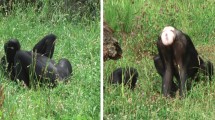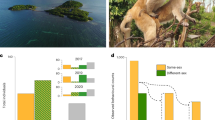Mounting is generally considered to be a male-typical behavior. Female Japanese macaques, in certain populations, are unusual, in that they routinely mount other females. In this study, we examined to what extent female Japanese macaques mount same-sex partners in a male-typical manner. We compared the mount postures males and females adopt and their rate of pelvic thrusting. In addition, we employed a modified form of Laban Movement Analysis (LMA) to compare patterns of pelvic movement during mounts. LMA is a universal language for movement that describes quantitative features of movement, such as changes in the relation of the body segments, as well as qualitative features, such as the style of movements. Our results indicate that female Japanese macaques do not mount in a male-typical manner. Females exhibited a much greater variety of mount postures than did males. Some of the most common types of mount postures employed by females were never exhibited by males. Females performed fewer pelvic thrusts per mount than males, but they executed more pelvic movements per mount, as well as, greater variety and complexity of movement. In addition, the qualitative style of pelvic mounting that females employed differed, in general, from that of males. We argue that these sex differences in mounting can be explained by the fact that both sexes sought sexual reward via genital stimulation during mounting, but they did so in different ways owing to the constraints imposed by their genital architecture. This study raises the larger question as to what constitutes a male-typical or female-typical behavior.






Similar content being viewed by others
REFERENCES
Adkins-Regan, E. (1988). Sex hormones and sexual orientation in animals. Psychobiology, 16, 335–347.
Adkins-Regan, E. (1998). Hormonal mechanisms of mate choice. American Zoologist, 38, 166–178.
Adkins-Regan, E., Mansukhani, V., Thompson, R., & Yang, S. (1997). Organizational actions of sex hormones on sexual partner preference. Brain Research Bulletin, 44, 497–502.
Altmann, J. (1974). Observational studies of behavior: Sampling methods. Behaviour, 49, 227–265.
Aou, S., Oomura, Y., & Yoshimatsu, H. (1988). Neuron activity of the ventromedial hypothalamus and the medial preoptic area of the female monkey during sexual behavior. Brain Research, 455, 65–71.
Bagemihl, B. (1999). Biological exuberance: Animal homosexual and natural diversity. New York: St. Martin's.
Barternieff, I., & Lewis, D. (1980). Body movement: Coping with the environment. Langhorne, PA: Gordon & Breach Science.
Baum, M. J. (1979). Differentiation of coital behavior in mammals. Neuroscience and Biobehavior Reviews, 3, 65–84.
Beach, F. A. (1968). Factors involved in the control of mounting behavior by female mammals. In M. Diamond (Ed.), Perspectives in reproduction and sexual behavior (pp. 83–131). Bloomington: Indiana University Press.
Chapais, B. (1992). The role of alliances in the social inheritance of rank among female primates. In A. Harcourt & F. M. B. de Waal (Eds.), Coalitions and alliances in humans and other animals (pp. 29–60). Oxford: Oxford University Press.
Chapais, B., Gauthier, C., Prud'homme, J., & Vasey, P. L. (1997). Relatedness threshold for nepotism in Japanese macaques. Animal Behaviour, 53, 533–548.
Chapais, B., & Mignault, C. (1991). Homosexual incest avoidance among females in captive Japanese macaques. American Journal of Primatology, 23, 171–183.
Dixson, A. F. (1998). Primate sexuality: Comparative studies of prosimians, monkeys, apes and human beings. Oxford: Oxford University Press.
Eaton, G. G., Glick, B. B., Worlein, J. M., & Martin, T. L. (1987). Sexual behavior at puberty in prenatally androgenized female Japanese macaques. American Journal of Primatology, 12, 340.
Eaton, G. G., Goy, R. W., & Phoenix, C. H. (1973). Effects of testosterone treatment in adulthood on sexual behavior of female pseudohermaphrodite rhesus monkeys. Nature New Biology, 242, 119–120.
Eaton, G. G., Worlein, J. M., Martin, T. L., & Glick, B. B. (1988). Sexual behavior of prenatally androgenized female and estrogen treated male Japanese macaques (Macaca fuscata). American Journal of Primatology, 14, 419.
Ellis, L., & Ames, M. A. (1987). Neurohormonal functioning and sexual orientation: A theory of homosexuality–heterosexuality. Psychological Bulletin, 101, 233–258.
Fagen, R., Conitz, J., & Kunibe, E. (2000). Observing behavioral qualities. International Journal of Comparative Psychology, 10, 167–179.
Fedigan, L. M., & Gouzoules, H. (1978). The consort relationship in a troop of Japanese monkeys. In D. J. Chivers & J. Herbert (Eds.), Recent advances in primatology, Vol. 1: Behavior (pp. 493–495). New York: Academic.
Fischer, R. B., & Nadler, R. D. (1978). Affiliative, playful, and homosexual interactions of adult female lowland gorillas. Primates, 19, 657–664.
Foroud, A., & Pellis, S. M. (2003). The development of “roughness” in the play fighting of rats: A Laban Movement Analysis perspective. Developmental Psychobiology, 42, 35–43.
Foroud, A., Whishaw, I. Q., & Pellis, S. M. (2004). Experience and cortical control over the pubertal transition to rougher play fighting in rats. Behavioral Brain Research, 149, 69–76.
Gouzoules, H., & Goy, R. W. (1983). Physiological and social influences on mounting behavior of troop-living female monkeys (Macaca fuscata). American Journal of Primatology, 5, 39–49.
Huffman, M. A. (1991). History of the Arashiyama Japanese macaques in Kyoto, Japan. In L. M. Fedigan & P. J. Asquith (Eds.), The monkeys of Arashiyama: Thirty-five years of research in Japan and the West (pp. 21–53). Albany: SUNY Press.
Hunt, G. L., Newman, A. L., Warner, M. H., Wingfield, J. C., & Kaiwi, J. (1984). Comparative behavior of male–female and female–female pairs among western gulls prior to egg-laying. Condor, 86, 157–162.
Hutchins, M. (1984). The mother–offspring relationship in mountain goats (Oreamnos americanus). Unpublished doctoral dissertation, University of Washington.
Hutchinson, A. (1977). Labanotation: The system of analyzing and recording movement (3rd ed.). New York: Theatre Arts Books.
Kendrick, K. M., & Dixson, A. F. (1986). Anteromedial hypothalamic lesions block proceptivity but not receptivity in the female common marmoset (Callithrix jacchus). Brain Research, 375, 221–229.
Koyama, N. (1991). Grooming relationships in the Arashiyama group of Japanese monkeys. In L. M. Fedigan & P. J. Asquith (Eds.), The monkeys of Arashiyama: Thirty-five years of research in Japan and the West (pp. 211–226). Albany: SUNY Press.
Koyama, Y., Fujita, I., Aou, S., & Oomura, Y. (1988). Proceptive presenting elicited by electrical stimulation of the female monkey hypothalamus. Brain Research, 446, 199–203.
Kurland, J. A. (1977). Kin selection in the Japanese monkey. Basel: Karger.
Laban, R. (1971). In L. Ullman (Ed.), The mastery of movement (Rev. 3rd ed.). Boston: Plays.
MacDonald, D. W. (1987). Running with the fox. New York: Facts on File.
Maletic, V. (1987). Body, space, expression: The development of Rudolf Laban's movement and dance concepts. New York: Mouton de Gnoyter.
Oomura, Y., Aou, S., Koyama, Y., Fujita, I., & Yoshimatsu, H. (1988). Central control of sexual behavior. Brain Research Bulletin, 20, 863–870.
Parker, G. A., & Pearson, R. G. (1976). A possible origin and adaptive significance of mounting behavior shown by some female mammals in oestrous. Journal of Natural History, 10, 241–245.
Phoenix, C. H., & Chambers, K. C. (1982). Sexual behavior in adult gonadectomized female pseudohermaphrodite, female, and male rhesus macaques (Macaca mulatta) treated with estradiol benzoate and testosterone propionate. Journal of Comparative Physiological Psychology, 96, 823–833.
Phoenix, C. H., Goy, R. W., Gerall, A. A., & Young, W. C. (1959). Organizing action of prenatally administered testosterone propionate on the tissues mediating mating behavior in the female guinea pig. Endocrinology, 65, 369–382.
Pomerantz, S. M., Goy, R. W., & Roy, M. M. (1986). Expression of male-typical behavior in adult female pseudohermaphroditic rhesus: Comparisons with normal males and neonatally gonadectomized males and females. Hormones and Behavior, 20, 483–500.
Takahata, Y. (1982). The sociosexual behavior of Japanese macaques. Zeitschrift für Tierpsychologie, 59, 89–108.
Vasey, P. L. (1995). Homosexual behavior in primates: A review of evidence and theory. International Journal of Primatology, 16, 173–204.
Vasey, P. L. (1996). Interventions and alliance formation between female Japanese macaques, Macaca fuscata, during homosexual consortships. Animal Behaviour, 52, 539–551.
Vasey, P. L. (1998). Female choice and inter-sexual competition for female sexual partners in Japanese macaques. Behaviour, 135, 579–597.
Vasey, P. L. (2002a). Sexual partner preference in female Japanese macaques. Archives of Sexual Behavior, 31, 45–56.
Vasey, P. L. (2002b). Same-sex sexual partner preference in hormonally and neurologically unmanipulated animals. Annual Review of Sex Research, 13, 141–179.
Vasey, P. L. (2004a). Homosexual behavior. In B. Thierry, M. Singh, & W. Kaumanns (Eds.), Macaque societies: A model for the study of social organization (pp. 151–154). Cambridge, UK: Cambridge University Press.
Vasey, P. L. (2004b). Pre- and post-conflict interactions among female Japanese macaques during homosexual consortships. International Journal of Comparative Psychology, 17, 351–359.
Vasey, P. L. (2004c). Sex differences in sexual partner acquisition, retention and harassment during female homosexual consortships in Japanese macaques. American Journal of Primatology, 64, 397–409.
Vasey, P. L., Chapais, B., & Gauthier, C. (1998). Mounting interactions between female Japanese macaques: Testing the influence of dominance and aggression. Ethology, 104, 387–398.
Vasey, P. L., & Duckworth, N. (in preparation). Sexual reward via vulvar and perineal stimulation as a proximate mechanism for female–female mounting in Japanese macaques.
Vasey, P. L., & Gauthier, C. (2000). Skewed sex ratios and female homosexual activity in Japanese macaques: An experimental analysis. Primates, 41, 17–25.
Vasey, P. L., & Pfaus, J. G. (2005). A sexually dimorphic hypothalamic nucleus in a macaque species with frequent female–female mounting and same-sex sexual partner preference. Behavioral Brain Research, 157, 265–272.
Wallen, K., & Parson, W. A. (1997). Sexual behavior in same-sexed nonhuman primates: Is it relevant to understanding human homosexuality? Annual Review of Sex Research, 7, 195– 225.
Whishaw, I. Q., Gorny, B., Foroud, A., & Kleim, J. (2003). Long–Evans and Sprague–Dawley rats have similar skilled reaching success and topographic limb representations in motor cortex but use different movements as assessed by EWMN and Laban Movement Analysis. Behavioral Brain Research, 145, 221–232.
Wickler, W. (1967). Socio-sexual signals and their intra-specific imitation among primates. In D. Morris (Ed.), Primate ethology (pp. 69–147). London: Weidenfield & Nicolson.
Wolfe, L. D. (1979). Behavioral patterns of estrous females of the Arashiyama West troop of Japanese macaques (Macaca fuscata). Primates, 20, 525–534.
Wolfe, L. D. (1984). Japanese macaque female sexual behavior: A comparison of Arashiyama East and West. In M. F. Small (Ed.), Female primates: Studies by women primatologists (pp. 141–157). New York: Alan R. Liss.
Yamagiwa, J., & Hill, D. A. (1998). Intraspecific variation in social organization of Japanese macaques: Past and present scope of field studies in natural habitats. Primates, 39, 257– 274.
ACKNOWLEDGMENTS
We are extremely thankful to the following individuals, without whom, this research would not have been possible: Shigeru Suzuki, Shinsuke Asaba, Michael Huffman, Juichi Yamagiwa, Mr. Kowbatake, Mr. Inoue, the Enomoto family of Arashiyama, and the Sakami family of Tokyo. We also thank theKenneth Zuckerand three anonymous referees. This research was funded by grants to P.L.V. by the University of Lethbridge, the L.S.B. Leakey Foundation, the Natural Science and Engineering Research Council (NSERC) of Canada, by a NSERC Undergraduate Award to N.D., and by a Mount Holyoke College Bardwell Fellowship and Biology Post-Graduate Fellowship to S.D.K.
Author information
Authors and Affiliations
Corresponding author
Rights and permissions
About this article
Cite this article
Vasey, P.L., Foroud, A., Duckworth, N. et al. Male–Female and Female–Female Mounting in Japanese Macaques: A Comparative Study of Posture and Movement. Arch Sex Behav 35, 116–128 (2006). https://doi.org/10.1007/s10508-005-9007-1
Received:
Revised:
Accepted:
Published:
Issue Date:
DOI: https://doi.org/10.1007/s10508-005-9007-1




